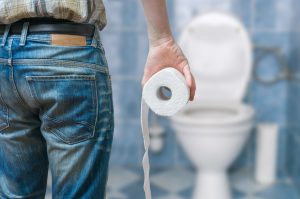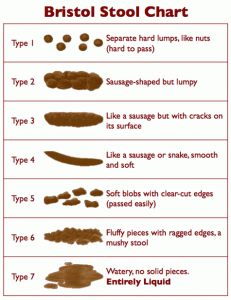 The subject of stool warrants plenty of attention. That’s because your poop color, smell, and shape say a lot about your health.
The subject of stool warrants plenty of attention. That’s because your poop color, smell, and shape say a lot about your health.
Basically, your bodily emissions are whatever is left behind once your digestive system completes absorbing nutrients and fluid from the foods and drinks you consume. During a lifetime, the average person produces roughly five tons of poop. The majority of waste discharged from your bowels is about 75 percent water, with the remainder being both dead and live bacteria; undigested food particles; miscellaneous cells; fiber; mucous; proteins and salts; as well as other matter.
Advertisement
On average, though, the human body needs between 18 and 72 hours to convert food into this waste before passing it out of your system. While some people have a bowel movement once daily or three times per week, those who could be described as more “regular” do so as many as three times every day. Of course, bathroom habits vary due to diet, exercise, travel, stress, medications, hormonal fluctuations, sleep patterns, illness, surgery, and childbirth. And the ease with which you move your bowels is far more important than frequency. Generally, you needn’t push or strain yourself during the process. It should be as effortless as peeing or passing some gas.
On the other hand, when the frequency of your defecation is reduced while the transit time is prolonged, you may be constipated. Not fun! This results in dry, hardened excrement. Those over the age of 65 run the risk of becoming constipated the most and should therefore pay closer attention to their stools.
The Mayo Clinic reports that 26 percent of women and 16 percent of men 65 years and older consider themselves constipated. In people over 84, the reported incidence is 34 and 26 percent, respectively. You may be surprised to learn that your predisposition to constipation is not a direct consequence of normal aging. It’s most often caused by medications that affect nerve conduction and smooth muscle function. The gears in your colon just don’t work as efficiently. Other factors that put seniors at risk of constipation include low-fiber diets, limited fluid intake, impaired mobility, and cognitive disorders.
The problem is, chronic, untreated constipation can cause a serious medical condition known as fecal impaction. Laxatives in these cases should be avoided and taken only as a final resort – and for a short period only. Frequent use can weaken the bowel wall muscles and affect nerve function, tampering with your body’s operating systems.
Reading your poop – The Poop Chart
Do you remember when you were in summer camp, when you were told before going to the bathroom, “If it’s brown, flush it down”? Well, you should always stick around for a moment before you do.
The smell, color, consistency, and shape of your fecal matter can reveal how your gastrointestinal tract is working and offer unique insight into your health.
Changes to your stool may be harmless and even temporary, suggesting digestive issues, lactose intolerance, or an adverse reaction to fructose or gluten. But other times, they may indicate problems as serious as infections or cancer, calling for immediate medical attention and intervention.
Here’s a handy stool chart – the Bristol Stool Scale – developed by Dr. Ken Heaton in Bristol, England and first published in 1997. It is designed to classify the various forms of human stools into seven categories, so you can make some notes on your own poop.

Poop measured: The Bristol Stool Scale chart
Constipation: Type 1, 2
Harder, pellet-like poop reveals varying degrees of constipation. And so-called “floaters” typically happen when the body improperly digests fat and nutrients. You know the ones! This stool has low water content, making it difficult to pass. It can also be scratchy and may cause irritation or damage to the anal passage. What to do? Drink more water, increase the fiber in your diet, and get active! Bowel movements are facilitated by walking.
Healthy stool: Type 3, 4
Generally, your stool should appear brown, smooth, and soft‚ sometimes lumpy, but resembling a sausage or a snake. There’s no need to read the paper for long on the toilet because you’re able to do the job with ease, no frowning or straining. Since this is a normal stool, you’re good to go. However, you could drink more water, increase your fiber, and boost your exercise to counter stress and promote healthy bowel movements.
Diarrhea: Type 5, 6, 7
Incredibly loose stools, on the other hand, can occur whenever you take in too much milk, caffeine, vitamin C, magnesium, and antibiotics, as well as really bad food. Irritable bowel syndrome (IBS) and general sickness can also lead to the same. Type 5, soft blobs with clear-cut edges is borderline normal stool, so, again, keep hydrated and eat more fiber-rich fresh fruits and veggies. Fiber helps to sweep the colon, feed our healthy intestinal bacteria, and slow the digestion of food so that we stay full longer and our blood sugar remains at a healthy balance. Types 6 and 7 stools spell trouble and possible infection. Drink plenty of liquids to counter the dehydration; rehydration salts can be helpful to restore lost electrolytes. Definitely contact your doctor if it continues.
As far as pus- or mucus-containing stools are concerned, these can mean an infection, inflammation, or irritation of the gastrointestinal tract. But they can also reveal more serious digestive conditions, such as Crohn’s disease, ulcerative colitis, IBS, and colon cancer.
Narrow stool, which happens every so often, is not problematic. But a thin stool could be symptomatic of IBS, for instance. And pencil-thin stool may reveal a colon obstruction possibly brought on by colon cancer.
Bad odor
The smell of stool is objectionable under normal circumstances. But a relatively bad odor should not be ignored. It is linked to a host of health problems: malabsorptive disorder, celiac disease, Crohn’s disease, chronic pancreatitis, and cystic fibrosis (CF), which causes your body to produce mucus that is rather thick and sticky. Mostly affecting infants and toddlers, this gene-related disease brings about both life-threatening lung infections and significant digestive issues.
As far as flatulence is concerned, not only is passing gas normal, it’s a strong indication that trillions of gut bacteria are hard at work doing what they do best. On average, people pass gas about 14 times daily. That’s roughly one to four pints. And 99 percent of this flatulence is completely without odor.
What your stool color says about your health
The color of your stool says a great deal about you, too. If your excrement is reddish in color, it could mean that you’re eating way too many watermelons, cherries, licorice, or beets. If it’s black and tarry, you may be taking too many iron pills or Pepto Bismol. But if your stool remains black in color, you may have a bleeding ulcer or upper gastrointestinal tract.
On the other hand, bloody streaks on the outside of your stool may be the direct result of hemorrhoids or a strained sphincter due to constipation. White or grayish excrement may either reflect a lack of water or too many antacids or calcium supplements in your system. Pale foods, such as rice, can cause this, too. Mucus in the stool can give it a whitish appearance, possibly caused by inflammation or benign conditions like irritable bowel syndrome (IBS). Far more seriously, though, such stools may be signs of a problematic gallbladder or liver, or fat malabsorption, as with pancreatitis and pancreatic cancer.
Yellow stool, meanwhile, may indicate that food is passing through your digestive tract too quickly or your bile output is insufficient; a gallbladder dysfunction causes the improper handling of bile.
Yellow stool is also seen in people who have the contagious disease Giardiasis, which is caused by a microscopic parasite, and gastro esophageal reflux disease – or GERD – which is when stomach acid comes up from the stomach and into the esophagus, adversely affecting it.
Finally, green stool may occur if you consume too many leafy green vegetables or food containing the same coloring, such as in ice cream, cake frosting, and jelly beans, etc. It can also be brought on by excessive amounts of iron or supplements – natural or otherwise –in your system. Usually, iron-rich foods will stain excrement if your body doesn’t absorb it all. But a stomach virus can also lead to stool that is slimy and green.
| Stool color | What it may mean | Possible dietary causes |
|---|---|---|
| Green | Food may be moving through the large intestine too quickly, such as due to diarrhea. As a result, bile doesn’t have time to break down completely. | Green leafy vegetables, green food coloring, such as in flavored drink mixes or ice pops, iron supplements. |
| Light-colored, white- or clay-colored | A lack of bile in stool. This may indicate a bile duct obstruction. | Certain medications, such as large doses of bismuth subsalicylate (Kaopectate, Pepto-Bismol) and other anti-diarrheal drugs. |
| Yellow, greasy, foul-smelling | Excess fat in the stool, such as due to a malabsorption disorder, for example, celiac disease. | Sometimes, the protein gluten, such as in breads and cereals. But see a doctor for evaluation. |
| Black | Bleeding in the upper gastrointestinal tract, such as the stomach. | Iron supplements, bismuth subsalicylate (Kaopectate, Pepto-Bismol), black licorice. |
| Bright red | Bleeding in the lower intestinal tract, such as the large intestine or rectum, often from hemorrhoids. | Red food coloring, beets, cranberries, tomato juice or soup, red gelatin or drink mixes. |
How to poop for the better
The good news is that you can track these changes in your stool. And by simply adjusting your everyday diet and lifestyle, you can do something about them while resolving gastrointestinal problems.
Eat for your colon health! Your diet should include whole foods, such as organic vegetables and fruits that provide essential nutrients and fiber.
Cut out artificial sweeteners, excessive amounts of caffeine, and sugar – especially fructose – chemical additives and processed foods because they are all detrimental to your gastrointestinal functions.
Boost your intestinal flora by adding naturally fermented foods into your diet, such as sauerkraut, pickles, and kefir, especially if you’re not receiving positive bacteria from the foods you eat alone.
Advertisement
Try increasing your fiber intake by consuming about 35 grams psyllium and freshly ground organic flax seed per day, for example.
Be sure to stay well hydrated with fresh, pure water. Get plenty of exercise. Avoid the painkillers codeine or hydrocodone, which will slow down your bowel movements, and antidepressants and antibiotics, which can also disrupt your gastrointestinal functions. Consider squatting as opposed to sitting: squatting actually straightens your rectum and relaxes your puborectalis muscle, helping you to empty your bowel without ever straining, as well as relieve constipation and hemorrhoids. Even consider getting yourself a bidet.
So if you are someone who quickly flushes without ever looking into the toilet bowl, you may wish to slow down and have a peek the next time around. The smell, color, consistency, and shape of your fecal matter could say a whole lot about your digestive tract, not to mention your overall health. And remember: If you see any consistent, dramatic changes in your waste, be sure to visit your doctor straightaway.
